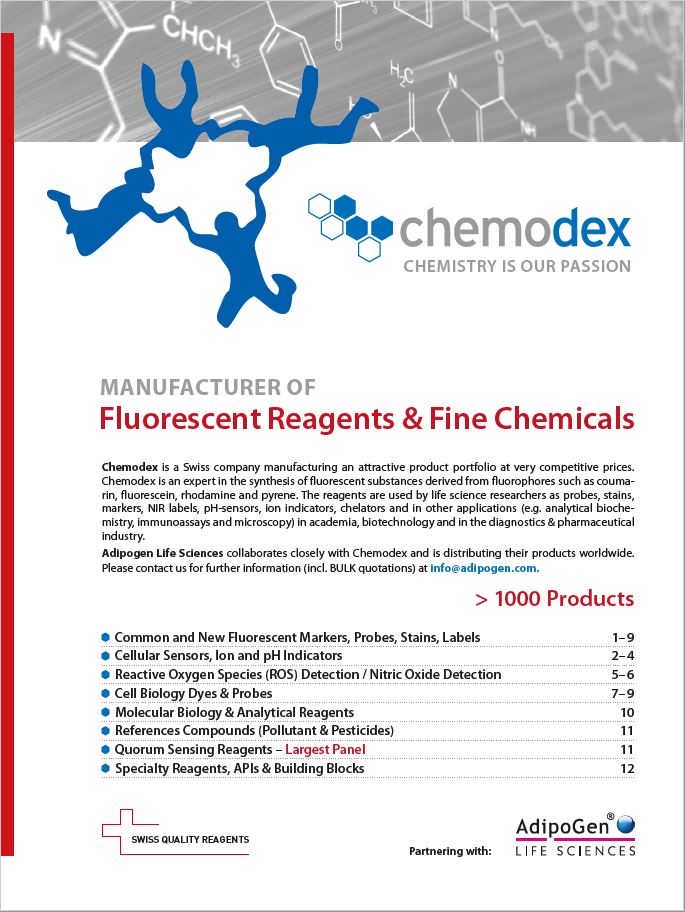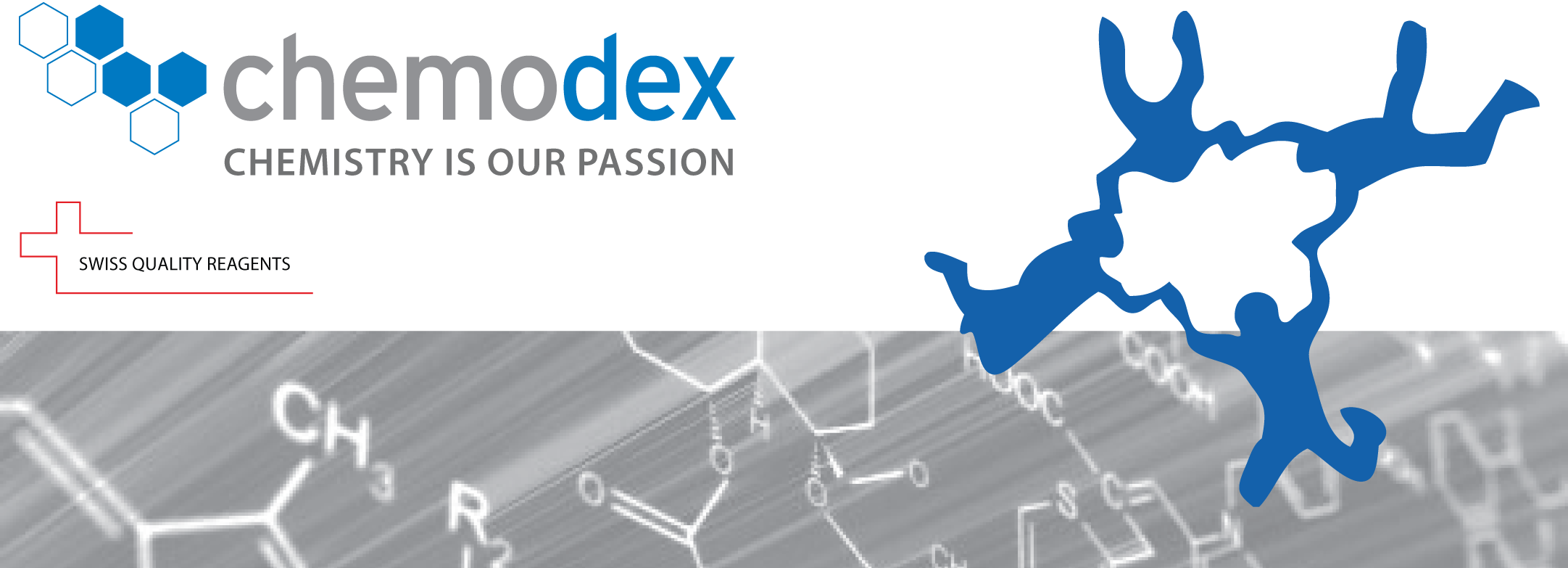Cookie Policy: This site uses cookies to improve your experience. You can find out more about our use of cookies in our Privacy Policy. By continuing to browse this site you agree to our use of cookies.
Chemodex Ltd - Labels, Stains and Molecular Probes
Chemodex - Chemistry is our Passion
Chemodex is a Swiss company manufacturing an attractive product portfolio at very competitive prices. The product offering includes:
- Common and New Fluorescent Probes
- Stains/Labels/Dyes
- Markers & Probes
- Metabolites
- Building Blocks & Small Molecules
Chemodex is an expert in the synthesis of fluorescent substances derived from fluorophores such as coumarin, fluorescein, rhodamine and pyrene. The reagents are used as probes, stains, markers, NIR-labels, pH-sensors, ion indicators, chelators and in other applications (e.g. analytical biochemistry, immunoassays and microscopy) by life science researchers in academia, biotechnology and the diagnostics & pharmaceutical industry.
AdipoGen Life Sciences provides all Chemodex Reagents worldwide. Please contact us if you request further information.
For Product Inquiries: info@adipogen.com
Selected Labels, Stains and Probes
| Product Name | PID | Product description |
| Alcian Blue 8GX Alcian Blue 8GX Solution |
CDX-A0001 CDX-A0201 |
Widely used cationic bluish-green dyes for both light and electron microscopy to stain acidic polysaccharides such as glycosaminoglycans in cartilages and other body structures, some types of mucopolysaccharides, sialylated glycocalyx of cells etc. Can be used to quantitate acidic glycans both in microspectrophotometric quantitation in solution or for staining glycoproteins in polyacrylamide gels or on western blots. |
| Hoechst 33258 other Hoechst Dyes |
CDX-B0029 | Fluorescent nucleic acid stain useful for staining DNA, chromosomes, nuclei and mitochondria. Binds to the minor groove of DNA at AT-rich sequences. This dye is commonly used for quantitating double-stranded DNA (dsDNA) of viable cells without detergent treatment or fixation and for fluorescence microscopy or flow cytometry. This dye also allows for quantitative measurements when plotted in a standard emission-to-content curve. |
| NBD-Cl other NBD Labels |
CDX-C0010 | Non-fluorescent. Generates highly fluorescent products upon reacting with aliphatic amines, amino acids, peptides and proteins or thiol compounds. Widely used to label peptides, proteins, drugs and other biomolecules. It is a popular derivatizing reagent for HPLC analysis of amino acids and low molecular weight amines. |
| 5-FAM | CDX-C0014 | Single isomer that can be used to react with primary amines via carbodiimide activation of the carboxylic acid. One of the most popular green fluorescent reagents used for click chemistry labeling of peptides, proteins, nucleotides or even small molecules. Has a relatively high absorptivity, excellent fluorescence quantum yield, and good water solubility. Commonly employed as a polar tracer. |
| 5-CFDA other CFDA Substrates |
CDX-C0039 | Popular cell permeant, sensitive, fluorescent substrate for measuring esterase activity in live cells. Used in cell viability assays and "Live-Dead" assay systems, especially automated cell viability assays. The cleavage product produced upon enzymatic or chemical hydrolysis of the acetate group(s) is carboxyfluorescein which is well-retained inside live cells. Can be used to monitor cells by flow cytometry or fluorescence microscopy. |
| 7-Diethylaminocoumarin-3-carboxylic acid | CDX-D0036 | Fluorescent label for amine modification and protein conjugation. It has a strong blue fluorescence and can be used to create blue fluorescent bioconjugates or labeling synthetic peptides for high-throughput detection. |
| Laurdan | CDX-D0098 | Fluorescent probe used to investigate membrane qualities of the phospholipid bilayers of cell membranes, sensitive to membrane phase transitions as well as other alterations to membrane fluidity such as the penetration of water. Variations in membrane water content cause blue shifts in the laurdan emission spectrum, which are quantified by calculating the generalized polarization (GP). Can be applied to living cells. |
| Dil Stain | CDX-D0230 | Lipophilic orange-red fluorescent membrane stain that diffuses laterally to stain the entire cell. The fluorescence of this environment-sensitive dye is greatly enhanced when incorporated into membranes or bound to lipophilic biomolecules such as proteins. It shows a high extinction coefficient, polarity-dependent fluorescence and short excited-state lifetime. Often used for single molecule imaging, fate mapping and as a long-term tracer for neuronal and other cells. |
| Fluorescein-5-thiosemicarbazide other Fluorescein Probes |
CDX-F0005 | Used for labeling of cell-surface functional groups (glycophorins). It is a cell impermeant fluorescent probe useful for determining protein and peptide topology on the cell surface and detection of protein carbonyls in aging tissues. |
| GSH-Oet | CDX-G0006 | Membrane/lipid permeable derivative of GSH. Used to protect cells against radiation damage, oxidants and various toxic compounds including heavy metals. Protective agent against cellular damage. Undergoes hydrolysis by intracellular esterases thereby increasing intracellular GSH concentration. |
| 5-Maleimido-eosin | CDX-M0013 | Triplet probe used for the measurment of rotational diffusion of proteins in solution and in membranes, including myosin and pyruvate dehydrogenase. Bioconjugates made with the thiol-reactive eosin-5-maleimide can be used as phosphorescent probes or as photosensitizers. |
| Propidium iodide | CDX-P0023 | An intercalating agent and the most common red-fluorescent nuclear and chromosome counterstain. It is not permeant to live cells and can be used as a DNA stain for both flow cytometry, to evaluate cell viability or DNA content in cell cycle analysis, and microscopy to visualise the nucleus and other DNA containing organelles. It can be used to differentiate necrotic, apoptotic and normal cells. |
| Pyridoxal hydrochloride | CDX-P0118 | Used for the labeling of amino acids and their detection in picomolar amounts. Used in a variety of studies including those of media supplements. Pyridoxal is one of the three natural forms of vitamin B6, along with pyridoxamine and pyridoxine. All of these forms are converted in the human body into a single biologically active form, pyridoxal 5-phosphate. |
Selected Biological Active Compounds
| Product Name | PID | Product description |
| AVG-Cl | CDX-A0185 | Potent inhibitor of ethylene synthesis in plants acting at the level of 1-aminocyclopropanecarboxylic acid synthase. |
| Dimidium bromide | CDX-D0065 | Intercalating probe for nucleic acids. Other applications include the determination of cationic surfactants. |
| 2-Heptyl-3-hydroxyl-4-quinolone | CDX-H0077 | Quorum sensing-regulated virulence factor used to induce and study the regulation of virulence genes such as those involved in iron scavenging. Quorum sensing is a signaling system used by bacteria to coordinate activity based upon their population density. The system involves the exchange of signaling molecules among bacteria via cell receptors. |
DAF Compounds - Fluorescent Probes for the Detection of Nitric Oxide
Nitric oxide (NO) is involved in various physiological and pathological processes in the cell and has been implicated in vasodilation, neurotransmission, cytotoxicity, immune response and inflammation. Within cells, nitric oxide synthase (NOS) catalyses the conversion of arginine to citrulline and NO in the presence of molecular oxygen, tetrahydrobiopterin, NADPH and flavin cofactors. Due to the importance of NO, real time detection and quantification of NO is of great interest. However, the extremely short half-life of NO limits the study of its physiological effect in vivo. Therefore NO-sensitive fluorescent probes, such as DAF-2 have been designed and used in real-time imaging of NO.
| Product Name | PID | Product description |
| DAF-2 | CDX-D0084 | Sensitive fluorescent probe for NO detection. |
| DAF-2 DA | CDX-D0085 | Cell permeable sensitive fluorescent probe for NO detection. |
| DAF-FM | CDX-A0023 | Probe used for quantitating low concentrations of NO in solution. Non-fluorescent until reaction with NO. |
| DAF-FM DA | CDX-A0024 | Cell permeable probe used for quantitating low concentrations of NO in solution. Non-fluorescent until reaction with NO. |
| DAF-2T | CDX-D0044 | Positive control for DAF-2. |
| DAR-1 | CDX-D0101 | Sensitive NO probe with higher photostability than the classical fluorescein derivative DAF. |
| DAR-2 | CDX-D0102 | Sensitive NO probe with higher photostability than the classical fluorescein derivative DAF. |
Zinc Probes for the Detection of Zn2+
Zinc (Zn) is the second most abundant transition metal in the body and it is essential as catalytic, structural and regulatory ion. Zinc ions are involved in homeostasis, immune responses, oxidative stress, apoptosis and aging. Zinc has been proposed to function as a conventional neurotransmitter for the presynaptic neuron and as a transmembrane signal to traverse the postsynaptic neuron. Aberrant zinc metabolism is associated with many neurological diseases including Alzheimer’s disease, Parkinson’s disease and epilepsy. The most suitable technique for in vivo monitoring of zinc has been proven to be fluroescent imaging using fluorescent zinc probes.
| Product Name | PID | Product description |
| ZnAF-2 DA | CDX-Z0008 | Cell permeable derivative of ZnAF-2. Fluorescent reagent suitable for the fluorimetric detection of Zn2+ (after esterase hydrolysis). |
| ZnAF-2 6-Iso | CDX-Z0006 | Membrane-impermeable compound that acts as a high-affinity Zn2+-specific fluorescent probe. Shows low basal fluorescence and the fluorescence intensity increases ~51-fold upon stoichiometric (1:1) binding to Zn2+. Exhibits little affinity towards Ca2+, Mg2+, Na+, or K+. |
| Zinquin free acid | CDX-Z0014 | Zn2+ specific fluorophore that forms zinquin-Zn2+ complexes. Used to detect zinc in cells by UV fluorescence. Intracellular zinc mobilization has been shown to be an early indicator of apoptosis. Emits in the blue region of the spectrum. |
| Zinquin ethyl ester | CDX-Z0013 | Lipophilic, zinc-sensitive, fluorescent derivative of Zinquin that is able to penetrate cell membranes. Cleavage of the ethyl ester group via cytosolic esterases in living cells impedes its efflux across the plasma membrane. Fluorescence is enhanced upon binding Zn2+ but the probe does not show a change in emission wavelength. The probe is UV-excitable and emits in the blue reqion of the spectrum. Zinquin ethyl ester has been used to monitor intracellular zinc fluxes associated with apoptosis. |
| See all Zn Probes from Chemodex! |
| More Information |
Product Catalog |
|
| Download the Chemodex Brochure 2022 |  Download |

